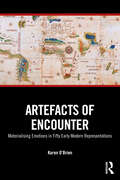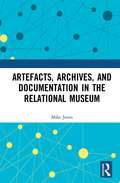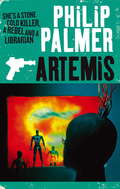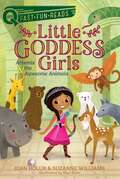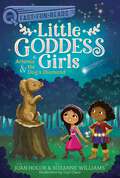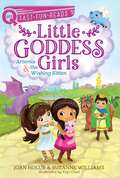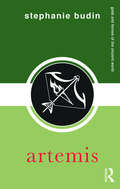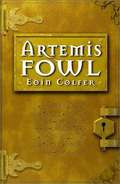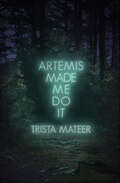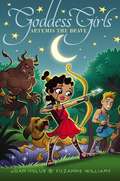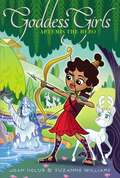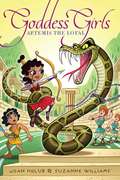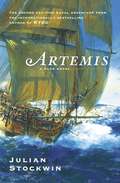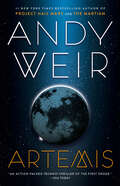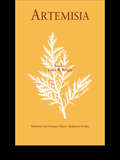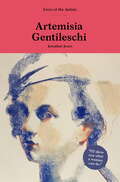- Table View
- List View
Artefacts of Encounter: Materialising Emotions in Fifty Early Modern Representations
by Karen O'BrienThis book presents corresponding images and essays of fifty early modern artefacts of encounters between European explorers and indigenous peoples, addressing relationships and material exchanges that extend beyond this framework to encompass diverse interactions across early modern societies.The artefacts selected for inclusion in this volume convey early modern visual dialogues, value systems and imagery through paintings, photographs, maps, drawings, buildings, books, icons, sacred sites and entities, dwellings and natural settings. Placing these objects within a comparative and international context, O’Brien considers the representation of these interactions as they are expressed through a wide gamut of human emotional experiences such as life, death, grief, pain, pleasure, belief, sadness and conflict, along with the extended perspective of image reproduction. In doing so, the book locates the realities of early modern existence – the emotional, legal, spiritual and violent encounters that encompass everyday experiences – in an expansive and varying spatial, cultural, geographical and temporal context. The book will interest students, scholars and general readers within a broad range of history subdisciplines including early modern history, indigenous history, comparative history and socio-legal history, and is also a useful text for undergraduate courses in politics, law, indigenous studies and global studies.
Artefacts, Archives, and Documentation in the Relational Museum
by Mike JonesArtefacts, Archives, and Documentation in the Relational Museum provides the first interdisciplinary study of the digital documentation of artefacts and archives in contemporary museums, while also exploring the implications of polyphonic, relational thinking on collections documentation. Drawing on case studies from Australia, the United Kingdom, and the United States, the book provides a critical examination of the history of collections management and documentation since the introduction of computers to museums in the 1960s, demonstrating how technology has contributed to the disconnection of distributed collections knowledge. Jones also highlights how separate documentation systems have developed, managed by distinct, increasingly professionalised staff, impacting our ability to understand and use what we find in museums and their ever-expanding online collections. Exploring this legacy allows us to rethink current practice, focusing less on individual objects and more on the rich stories and interconnected resources that lie at the heart of the contemporary, plural, participatory ‘relational museum.’ Artefacts, Archives, and Documentation in the Relational Museum is essential reading for those who wish to better understand the institutional silos found in museums, and the changes required to make museum knowledge more accessible. The book is a particularly important addition to the fields of museum studies, archival science, information management, and the history of cultural heritage technologies.
Artemia Biology
by Robert A. BrowneArtemia is widely used in both life-sciences research and aquaculture. Although there are over 4000 references regarding Artemia, the literature is widely scattered. Artemia Biology provides a comprehensive, state-of-the-art review of this literature, containing a considerable amount of previously unpublished data. Although all aspects of Artemia biology are covered, the book emphasizes whole-organism approaches. Topics covered include molecular genetics, ontogeny, clonal diversity, mitochondrial DNA-based phylogeny, and comparisons of Artemia and Parartemia (including a taxonomic key to Parartemia species). The book also contains the latest information on Artemia culturing in fertilized ponds and culture tanks, as well as the use of the organism as a food source. Researchers investigating basic biological questions involving molecular genetics, biochemistry, enzymatic and developmental activities, physiology, ecological genetics and adaptation, ecology, and aquaculture production will find this book indispensable.
Artemis
by Philip PalmerArtemis McIvor is a thief, a con-artist, and a stone cold killer. And she's been on a crime-spree for, well, for years. The galactic government has collapsed and the universe was hers for the taking.But when the cops finally catch up with her, they give Artemis a choice. Suffer in prison for the rest of her very long life, or join a crew of criminals, murderers, and traitors on a desperate mission to save humanity against an all-consuming threat.Now, Artemis has to figure out how to be a good guy without forgetting who she really is.
Artemis
by Philip PalmerShe's a stone cold killer, a rebel and a librarian ...Raised on the library planet of Rebus, Artemis McIvor has a love of books in a future where reading is a lost art. Unfortunately, she's also been imprisoned for a string of brutal murders she didn't commit. Not that she hasn't killed people. She just didn't kill these people.A war is coming and Artemis will find that her talents will be in high demand. But she has debts to pay and when they come due she will have a choice: fight for her freedom, or die a slave.
Artemis & the Awesome Animals: Little Goddess Girls 4 (QUIX)
by Joan Holub Suzanne WilliamsJoin little Artemis for a sweet, Wizard of Oz–inspired adventure in this fourth Little Goddess Girls story—part of the Aladdin QUIX line!All Artemis wants is the gift of courage. There are a lot of scary things out there! With the help of her new friends—Athena, Persephone, and Aphrodite—Artemis hopes she can ask the super-duper-powerful Zeus to help her be a little less afraid. But the mean green girl, Medusa, has other plans. Can Artemis dig deep, be brave, and help her friends find their way to Sparkle City? With the help of some animals who aren&’t what they seem, Artemis just might end up being an unexpected hero!
Artemis & the Dog's Diamond: A QUIX Book (Little Goddess Girls #12)
by Joan Holub Suzanne WilliamsArtemis and Orion help each other on their quests in this twelfth Little Goddess Girls story—part of the Aladdin QUIX line!Artemis is on the final quest to bring the last missing jewel—a diamond—back to Zeus. She ends up in the Forest of Lost and Found, where she meets a young hunter named Orion. He&’s looking for something, too: a dog! With some extra magic and the power of friendship, can Artemis and Orion both find what they are looking for?
Artemis & the Wishing Kitten: Little Goddess Girls 8 (QUIX)
by Joan Holub Suzanne WilliamsJoin little Artemis on a sweet adventure in this eighth Little Goddess Girls story—part of the Aladdin QUIX line!The Goddess Girls are on their way to the Sparkle City Pet Show when they discover a cute, pink kitten on the Hello Brick Road. Two boys, Prince Paris and Odysseus, both claim the kitten is theirs. Can Artemis figure out which boy is telling the truth and get the sweet kitty back home?
Artemis (Gods and Heroes of the Ancient World)
by Stephanie Lynn BudinArtemis is a literary, iconographic, and archaeological study of the ancient Greek goddess of the hunt, who presided over the transitions and mediations between the wild and the civilized, youth and maturity, life and death. Beginning with a study of the early origins of Artemis and her cult in the Bronze and Archaic Ages, Budin explores the goddess' persona and her role in the lives of her worshippers. This volume examines her birth and childhood, her place in the divine family, her virginity, and her associations with those places where the wilds become the "cities of just men." The focus then turns to Artemis’ role in the lives of children and women, particularly how she helps them navigate the transition to adulthood and, perhaps too often, death. Budin goes on to reconsider some of the more harrowing aspects of Artemis’ mythology, such as plague and bloodshed, while also examining some of her kinder, oft overlooked associations. Finally, the role of Artemis in the Renaissance and modern society is addressed, from the on-going fascination with the "breasts" on the statue of Artemis of Ephesos to the Artemisian aspects of Katniss Everdeen. Written in an accessible style, Artemis is a crucial resource for students not only of Greek myth, religion and cult, but also those seeking to understand the lives and roles of girls and women in ancient Greece, as this goddess presided over their significant milestones, from maiden to wife to mother.
Artemis Fowl (Artemis Fowl #1)
by Eoin ColferTwelve-year-old Artemis Fowl is a millionaire, a genius-and, above all, a criminal mastermind. But even Artemis doesn't know what he's taken on when he kidnaps a fairy, Captain Holly Short of the LEPrecon Unit. These aren't the fairies of bedtime stories; these fairies are armed and dangerous. <P><P> Artemis thinks he has them right where he wants them but then they stop playing by the rules.<P> Winner of Pacific Northwest Library Association’s Young Reader’s Choice Intermediate Award
Artemis Made Me Do It (Myth and Magick #2)
by Trista MateerBestselling and award-winning author Trista Mateer returns with another magical approach to self-care in her newest goddess-themed poetry collection, Artemis Made Me Do It. Using the framework of tarot and conversation, Mateer approaches myth through a witchcraft-inspired lens and uses it to explore timeless issues like burnout, survival, trauma, and the restorative power in taking control of your own lore. Artemis speaks to what is wild and untamed in all of us, and in this new collection, she asks for a moment of calm. This is the second book in the Myth & Magick series, which also includes Aphrodite Made Me Do It and Persephone Made Me Do It.
Artemis the Brave: Athena The Brain; Persephone The Phony; Aphrodite The Beauty; Artemis The Brave (Goddess Girls #4)
by Joan Holub Suzanne WilliamsIn Athena the Brain, Athena always knew she was smart and special, but she didn’t realize that she was a goddess! When she’s whisked away to Mount Olympus Academy, she worries about fitting in and dealing with her dad (Zeus). Luckily, she meets the Goddess Girls and finds the best friends she’s ever had.
Artemis the Brave: Book 4 (Goddess Girls #4)
by Joan Holub Suzanne WilliamsArtemis's friends and classmates see her as the most courageous goddessgirl at school. Little do they know that despite her expert archery skills, the smelly Geryon, ring-nosed Minotaurs, and scorpions in Beast-ology class scare her as much as they do anyone else! But what's really bothering her now is that funny feeling she has whenever she looks at Orion. She's never had a crush before. Will she find the courage to talk to Orion, to make him see her as more than a pal, and to ace Beast-ology class?The Goddess Girls series by Joan Holub and Suzanne Williams puts a modern spin on classic Greek myths! Follow the ins and outs of divine social life at Mount Olympus Academy where the most privileged godboys and goddessgirls in the Greek pantheon hone their mythical skills.
Artemis the Hero (Goddess Girls #28)
by Joan Holub Suzanne WilliamsMeet the treacherous Alpheus in this twenty-eighth Goddess Girls adventure!After the sneaky river god Alpheus takes a precious cup from a river nymph, it&’s up to Artemis to get it back! When Alpheus challenges Artemis to a surprisingly easy bet, with the winner getting the cup, Artemis thinks it&’s too good to be true—and realizes Alpheus will stop at nothing to win. Can Artemis be a hero to her friends?
Artemis the Loyal (Goddess Girls)
by Joan Holub Suzanne WilliamsIt's time for the annual Olympic Games, and the four goddessgirls are not happy! It's boys only--and the girls at MOA are not pleased. Led by Artemis, Athena, Persphone and Aphrodite, the ladies of Mount Olympus hatch a plan to get Zeus to open up the games to everyone. Will they succeed--or end up watching from the sidelines again?These classic myths from the Greek pantheon are given a modern twist that contemporary tweens can relate to, from dealing with bullies like Medusa to a first crush on an unlikely boy. Goddess Girls follows four goddesses-in-training – Athena, Persephone, Aphrodite, and Artemis – as they navigate the ins and outs of divine social life at Mount Olympus Academy, where the most priviledged gods and goddesses of the Greek pantheon hone their mythical skills.
Artemis: A Kydd Novel
by Julian StockwinWith Kydd, Julian Stockwin introduced us to a young wig-maker from Guildford who was kidnapped and pressed into duty with the tempestuous crew of the Duke William battle ship. Now, Thomas Paine Kydd is back -- with a vengeance -- in the latest installment of Stockwin's thrilling naval adventure series. Artemis is the eighteenth-century crack frigate that Kydd and sea-mate Nicholas Renzi are set to sail all the way to the fabled Far East. In this great age of fighting sailing ships, Kydd's voyage promises to be a perilous undertaking. But not even shipwreck, mutiny, or a confrontation with a mighty French frigate manages to thwart Artemis and her crew. It's only when Kydd receives an urgent message from home -- one that threatens to cut short his career and trap him on shore forever -- that Artemis's real journey begins. Filled with mesmerizing suspense and vivid details of Napoleonic-era seafaring, Artemis is classic, page-turning storytelling at its best.
Artemis: A Novel
by Andy Weir<P>The bestselling author of The Martian returns with an irresistible new near-future thriller—a heist story set on the moon. <P>Jazz Bashara is a criminal. Well, sort of. Life on Artemis, the first and only city on the moon, is tough if you’re not a rich tourist or an eccentric billionaire. So smuggling in the occasional harmless bit of contraband barely counts, right? Not when you've got debts to pay and your job as a porter barely covers the rent. <P>Everything changes when Jazz sees the chance to commit the perfect crime, with a reward too lucrative to turn down. But pulling off the impossible is just the start of her problems, as she learns that she's stepped square into a conspiracy for control of Artemis itself—and that now, her only chance at survival lies in a gambit even riskier than the first. <P><b>A New York Times Bestseller</b>
Artemis: The Indomitable Spirit in Everywoman
by Jean Shinoda Bolen&“Jean Shinoda Bolen provides ancient and modern ways to be our authentic, courageous, and passionate selves. Jean herself is an Artemis.&”—Gloria Steinem Worshiped in Ancient Greece as a protectress of young girls, Artemis was the goddess of hunting, nature, and chastity—the original &“wild woman.&” In Artemis, Jungian analyst and bestselling author, Jean Shinoda Bolen, revives the goddess Artemis to reclaim the female passion and persistence to survive and succeed. But an indomitable spirit isn&’t just reserved for the gods. In her book, Dr. Bolen revives the myth of Atalanta, an archetypal Artemis and mere mortal. To Atalanta, fate was no obstacle. Left to die because she was born a girl, she faces the Calydon Boar and outruns any man attempting to claim her as his wife. In Artemis, women are encouraged to discover their inner heroine—the activist who never gives up, who cannot be subdued. Whether women&’s rights activists or Princess Merida from Brave, the Artemis personality is embodied in the modern women. Hailed by Isabel Allende, as a &“beautiful, inspiring book,&” Artemis is dedicated to all women and girls who discover her unconquerable spirit in themselves or others. Inside find: · Examples of Artemis in real-life and popular culture · Ancient and modern ways to be your authentic self · A source of strength, power, and integrity &“Bolen connects Artemis to contemporary figures such as environmental activist Julia Butterfly Hill, author Cheryl Strayed, and journalist Lara Logan . . . Bolen also discusses other goddess archetypes, including the romance-oriented Aphrodite, contemplative Hestia, and Hecate, the wise crone. The exploration of Artemis and Atalanta as feminist icons is compelling.&”—Publishers Weekly
Artemis: Thomas Kydd 2
by Julian Stockwin'In Stockwin's hands the sea story will continue to entrance readers across the world' - GuardianIn the great age of fighting sail, life ranging the seas for prey and prize money in the crack frigate HMS Artemis is fast and exciting.Now a true Jack Tar, Kydd sails into Portsmouth Harbour and a hero's welcome after a ferocious battle against the French. However his jubilation is cut short when a family matter threatens to take him from the life he has grown to love; he must return to Guildford.But the sea beckons irresistibly and Kydd manages to ship out again in his beloved Artemis - a voyage that will take him to the fabled East and present him with fierce challenges, both personal and physical. Finally homeward bound, he faces death itself in the cruel waters of the Great Southern Ocean.********************What readers are saying about ARTEMIS'Fast and furious' - 5 stars'Superb' - 5 stars'I simply could not put it down' - 5 stars'Never fails to entertain!' - 5 stars'A great read for all who love the world of wooden ships when the Royal Navy ruled the seven seas' - 5 stars
Artemis: Thomas Kydd 2
by Julian Stockwin'In Stockwin's hands the sea story will continue to entrance readers across the world' - GuardianIn the great age of fighting sail, life ranging the seas for prey and prize money in the crack frigate HMS Artemis is fast and exciting.Now a true Jack Tar, Kydd sails into Portsmouth Harbour and a hero's welcome after a ferocious battle against the French. However his jubilation is cut short when a family matter threatens to take him from the life he has grown to love; he must return to Guildford.But the sea beckons irresistibly and Kydd manages to ship out again in his beloved Artemis - a voyage that will take him to the fabled East and present him with fierce challenges, both personal and physical. Finally homeward bound, he faces death itself in the cruel waters of the Great Southern Ocean.********************What readers are saying about ARTEMIS'Fast and furious' - 5 stars'Superb' - 5 stars'I simply could not put it down' - 5 stars'Never fails to entertain!' - 5 stars'A great read for all who love the world of wooden ships when the Royal Navy ruled the seven seas' - 5 stars
Artemisia (Medicinal And Aromatic Plants - Industrial Profiles Ser. #Vol. 18)
by Colin W. WrightA comprehensive overview of this genus, Artemisia examines all aspects of the herbs uses and applications, its mode of action and clinical importance. Following a comprehensive introduction to the genus, the book discusses the botanical, phytochemical and biological aspects of a number of important species of Artemisis. Considering that the discove
Artemisia Gentileschi
by Sheila BarkerThis second volume in the groundbreaking Illuminating Women Artists series delves into the stirring life and work of the Baroque painter Artemisia Gentileschi. The life of Artemisia Gentileschi (1593-after 1654) was as exceptional as her paintings. She was a child prodigy, raised without a mother by her artist father, a follower of Caravaggio. Although she learned to paint under her father, she became an artist against his wishes. Later, as she moved between Florence, Rome, Venice, Naples, and London, her artistic style evolved, but throughout her career she specialized in large-scale, powerful, nuanced portrayals of women. This book highlights Gentileschi's enterprising and original engagement with emerging feminist notions of the value and dignity of womanhood. Sheila Barker's cutting-edge scholarship in Artemisia Gentileschi clears a pathway for all audiences to appreciate the artist's pictorial intelligence, as well as her achievement of a remarkably lucrative and high-profile career at a time when few women were artists. Bringing to light newly attributed paintings and archival discoveries, this is the first biography to be written by an authority on Gentileschi since 1999. The volume is beautifully illustrated, and Barker weaves this extraordinary story with in-depth discussions of key artworks, such as Susanna and the Elders (1610), Judith Beheading Holofernes (c.1619-20), and Lot and His Daughters (1640-45). Also included is the J. Paul Getty Museum's recent acquisition, Lucretia (c.1635-45). Through such works, Barker explores the evolution of Gentileschi's expressive goals and techniques.
Artemisia Gentileschi (Lives Of The Artists Ser.)
by Jonathan JonesArtemisia Gentileschi was the greatest female artists of the Baroque age. In Artemisia Gentileschi, critic and historian Jonathan Jones discovers how Artemisia overcame a turbulent past to become one of the foremost painters of her day.As a young woman Artemisia was raped by her tutor, and then had to endure a seven-month-long trial during which she was brutally examined by the authorities. Gentileschi was shamed in a culture where honour was everything. Yet she went on to become one of the most sought-after artists of the seventeenth century. Yet she went on to become one of the most sought-after artists of the seventeenth century. Gentileschi's art communicated a powerful personal vision. Like Frida Kahlo, Louise Bourgeois or Tracey Emin, she put her life into her art.‘Lives of the Artists’is a new series of brief artists biographies from Laurence King Publishing. The series takes as its inspiration Giorgio Vasari's five-hundred-year-old masterwork, updating it with modern takes on the lives of key artists past and present. Focusing on the life of the artist rather than examining their work, each book also includes key images illustrating the artist’s life.
Artemisia Gentileschi (Lives of the Artists)
by Jonathan JonesArtemisia Gentileschi was the greatest female artists of the Baroque age. In Artemisia Gentileschi, critic and historian Jonathan Jones discovers how Artemisia overcame a turbulent past to become one of the foremost painters of her day. As a young woman Artemisia was raped by her tutor, and then had to endure a seven-month-long trial during which she was brutally examined by the authorities. Gentileschi was shamed in a culture where honour was everything. Yet she went on to become one of the most sought-after artists of the seventeenth century. Yet she went on to become one of the most sought-after artists of the seventeenth century. Gentileschi's art communicated a powerful personal vision. Like Frida Kahlo, Louise Bourgeois or Tracey Emin, she put her life into her art.‘Lives of the Artists’is a new series of brief artists biographies from Laurence King Publishing. The series takes as its inspiration Giorgio Vasari's five-hundred-year-old masterwork, updating it with modern takes on the lives of key artists past and present. Focusing on the life of the artist rather than examining their work, each book also includes key images illustrating the artist’s life.
